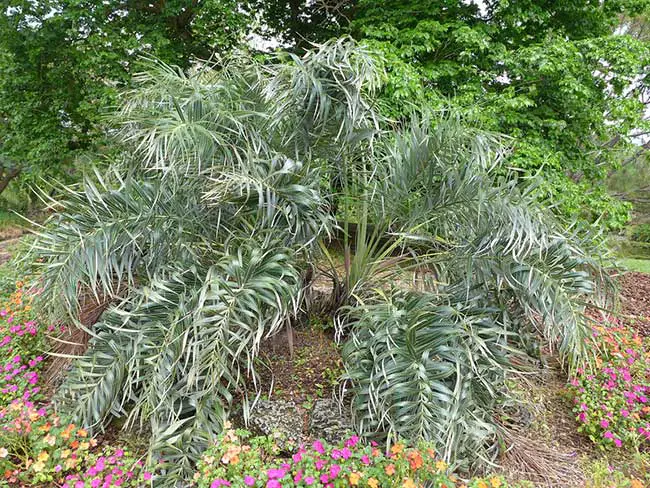
The Seashore Palm Tree, scientifically known as Allagoptera arenaria, is a small and captivating palm species native to coastal regions of Brazil. It is renowned for its ability to thrive in harsh seaside environments, making it well-suited for coastal landscaping.
This palm typically grows to a height of 3 to 10 feet (1 to 3 meters) and forms a clump of slender trunks. The trunks are covered with persistent leaf bases, giving them a textured appearance.
This palm’s adaptability to sandy and salty soils, along with its excellent salt tolerance, makes it an ideal choice for seaside gardens and landscapes.
Quick Facts:
| Scientific name: | Allagoptera arenaria |
| Common names: | Seashore Palm |
| Origin: | Native to coastal regions of Brazil. |
| Growth Rate: | Slow. Up to 3-10 ft tall and 2-5 ft wide. |
| Cold Tolerance: | USDA Zones 9a (20 to 25 F) to 11 (above 40 F). |
| Light Req: | Moderate, high |
| Water Req: | Some tolerance. |
| Soil Req: | Widely adaptable |
| Fruit: | Green to purple. Not edible. |
| Propagation: | Seeds. |
Seashore Palm Appearance
This palm typically grows to a height of 3 to 10 feet (1 to 3 meters), making it relatively small and suitable for various landscaping settings.
It forms a clump of slender trunks that are often covered with persistent leaf bases, giving them a textured and somewhat rugged appearance.
The fronds of the Seashore Palm are pinnate, which means they have feather-like, segmented leaves. These fronds gracefully arch outward from the center of the plant, creating an elegant and tropical look. They are typically 2 to 5 feet (0.6 to 1.5 meters) in length.
Fruits and Flowers of the Seashore Palm
The Seashore Palm (Allagoptera arenaria) produces small and unobtrusive flowers. These flowers are typically yellowish or cream in color and grow in clusters. While they are not particularly showy or fragrant, they play a vital role in the palm’s reproductive process by attracting pollinators, such as insects.
In terms of fruit, the Seashore Palm generates small, rounded fruits that are usually less than 1 inch (2.5 centimeters) in diameter. These fruits begin green and gradually ripen to a black or dark brown color when mature. While they are not commonly consumed by humans, they serve as a valuable food source for various wildlife species in the palm’s native coastal habitat.
Caring for the Seashore Palm
This palm thrives best in well-draining sandy or loamy soils, reminiscent of coastal beaches. It finds its comfort in abundant sunlight, basking in the glory of full sun to partial shade.
While it displays some drought tolerance as it matures, it appreciates regular watering, especially during its initial stages of growth. Ensuring that the soil remains consistently moist without becoming waterlogged is crucial for its health.
Feeding it with a balanced, slow-release palm fertilizer during the growing season can boost its vitality and enhance its lush appearance.
Pruning should be a gentle touch, primarily focused on the removal of dead or damaged fronds. The palm’s natural form is part of its charm, so over-pruning is best avoided.
The Seashore Palm exhibits a good degree of cold hardiness, particularly when it comes to its ability to tolerate salt-laden winds and coastal conditions. It is typically considered suitable for USDA hardiness zones 9a to 11, which encompass regions with mild and temperate climates.
In these zones, which include parts of Florida, Texas, and other Gulf Coast states, as well as coastal regions of California, the Seashore Palm can thrive and endure mild winter conditions without significant damage. It is notably well-adapted to seaside environments and can withstand the challenges of salt spray and sandy soils.
While the Seashore Palm is generally hardy against pests, occasional inspections for common issues like scale insects or mites are prudent. Swift action to address any pest-related challenges helps maintain its well-being.
Lastly, for those interested in growing more Seashore Palms, propagation from seeds is a viable option. Collect and clean the seeds before planting them in a suitable germination medium, ensuring warmth and adequate light for successful germination.
Seashore Palm Pictures




Comments are closed.